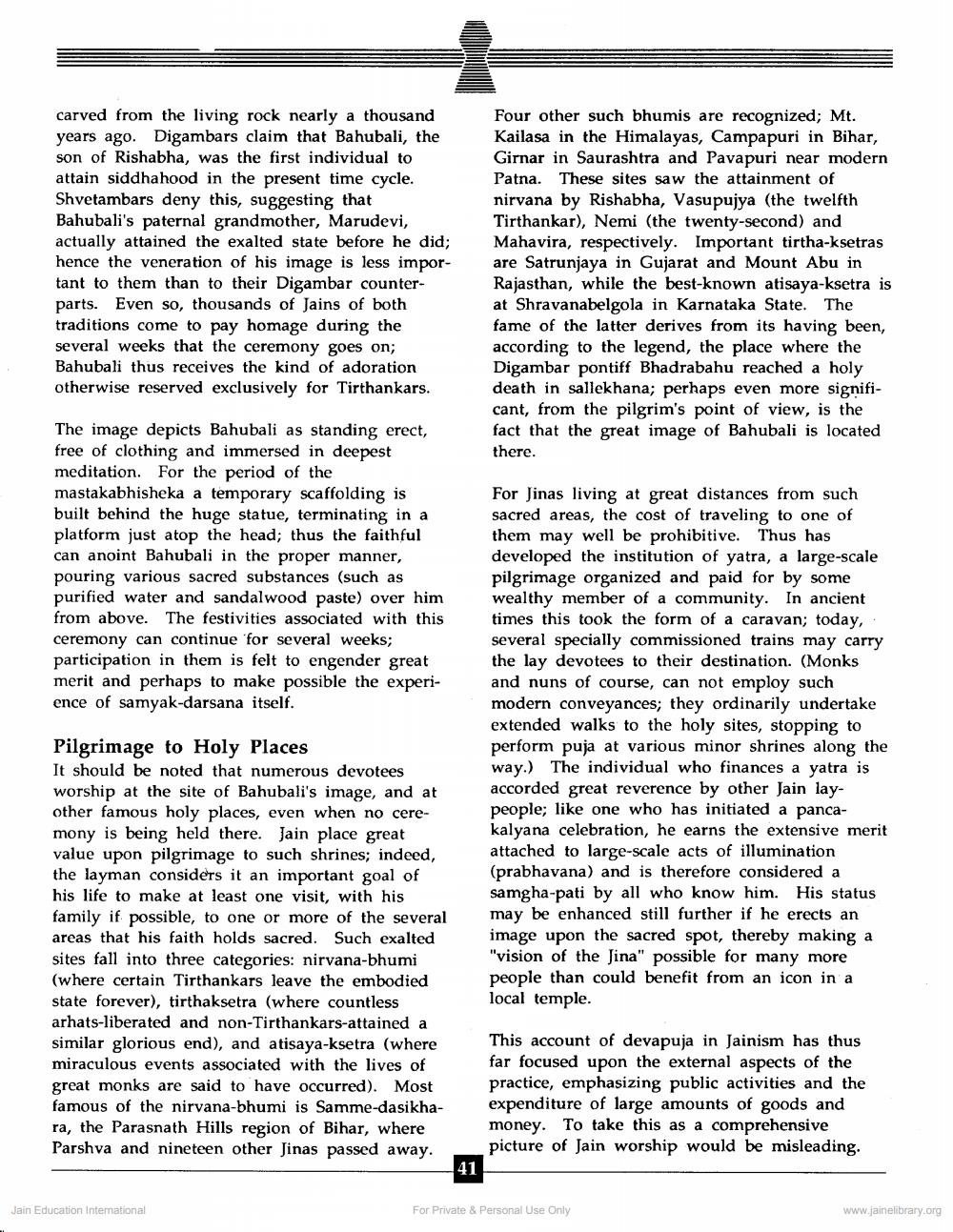________________
carved from the living rock nearly a thousand years ago. Digambars claim that Bahubali, the son of Rishabha, was the first individual to attain siddhahood in the present time cycle. Shvetambars deny this, suggesting that Bahubali's paternal grandmother, Marudevi, actually attained the exalted state before he did; hence the veneration of his image is less important to them than to their Digambar counterparts. Even so, thousands of Jains of both traditions come to pay homage during the several weeks that the ceremony goes on; Bahubali thus receives the kind of adoration otherwise reserved exclusively for Tirthankars.
The image depicts Bahubali as standing erect, free of clothing and immersed in deepest meditation. For the period of the mastakabhisheka a temporary scaffolding is built behind the huge statue, terminating in a platform just atop the head; thus the faithful can anoint Bahubali in the proper manner, pouring various sacred substances (such as purified water and sandalwood paste) over him from above. The festivities associated with this ceremony can continue for several weeks; participation in them is felt to engender great merit and perhaps to make possible the experience of samyak-darsana itself.
Pilgrimage to Holy Places
It should be noted that numerous devotees worship at the site of Bahubali's image, and at other famous holy places, even when no ceremony is being held there. Jain place great value upon pilgrimage to such shrines; indeed, the layman considers it an important goal of his life to make at least one visit, with his family if possible, to one or more of the several areas that his faith holds sacred. Such exalted sites fall into three categories: nirvana-bhumi (where certain Tirthankars leave the embodied state forever), tirthaksetra (where countless arhats-liberated and non-Tirthankars-attained a similar glorious end), and atisaya-ksetra (where miraculous events associated with the lives of great monks are said to have occurred). Most famous of the nirvana-bhumi is Samme-dasikhara, the Parasnath Hills region of Bihar, where Parshva and nineteen other Jinas passed away.
Jain Education International
41
Four other such bhumis are recognized; Mt. Kailasa in the Himalayas, Campapuri in Bihar, Girnar in Saurashtra and Pavapuri near modern Patna. These sites saw the attainment of nirvana by Rishabha, Vasupujya (the twelfth Tirthankar), Nemi (the twenty-second) and Mahavira, respectively. Important tirtha-ksetras are Satrunjaya in Gujarat and Mount Abu in Rajasthan, while the best-known atisaya-ksetra is at Shravanabelgola in Karnataka State. The fame of the latter derives from its having been, according to the legend, the place where the Digambar pontiff Bhadrabahu reached a holy death in sallekhana; perhaps even more significant, from the pilgrim's point of view, is the fact that the great image of Bahubali is located there.
For Jinas living at great distances from such sacred areas, the cost of traveling to one of them may well be prohibitive. Thus has developed the institution of yatra, a large-scale pilgrimage organized and paid for by some wealthy member of a community. In ancient times this took the form of a caravan; today, several specially commissioned trains may carry the lay devotees to their destination. (Monks and nuns of course, can not employ such modern conveyances; they ordinarily undertake extended walks to the holy sites, stopping to perform puja at various minor shrines along the way.) The individual who finances a yatra is accorded great reverence by other Jain laypeople; like one who has initiated a pancakalyana celebration, he earns the extensive merit attached to large-scale acts of illumination (prabhavana) and is therefore considered a samgha-pati by all who know him. His status may be enhanced still further if he erects an image upon the sacred spot, thereby making a "vision of the Jina" possible for many more people than could benefit from an icon in a local temple.
This account of devapuja in Jainism has thus far focused upon the external aspects of the practice, emphasizing public activities and the expenditure of large amounts of goods and money. To take this as a comprehensive picture of Jain worship would be misleading.
For Private & Personal Use Only
www.jainelibrary.org




